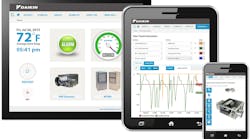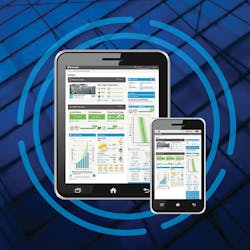By PAUL RAUKER, Daikin Applied, Minneapolis, Minn.
In the past few years, the HVAC industry has been hit over the head with the Internet of Things (IoT) and the potential it can offer commercial building managers and owners. We’ve witnessed adoption of IoT-enabled technology grow, particularly at commercial office spaces, as well as health care and education facilities.
As IoT-enabled HVAC equipment gains momentum in the commercial sector, facilities managers and operators are realizing the tangible benefits these products are delivering. Energy costs are dipping significantly, facility crews are taking a more efficient, predictive approach to maintenance, and service technicians are analyzing performance data to provide insight into performance trends to facility managers and operators.
It’s encouraging to see progress for many reasons. For one, more IoT-enabled products in the field means there is more data for service providers and HVAC system manufacturers to analyze, and apply to strengthen next-generation offerings to make them more beneficial for the user.
As we study and learn from these applications, the commercial HVAC industry is pivoting to make connected products mainstream. Part of this effort involves learning from industries outside of HVAC that are further along the adoption path. It’s also important to be purposeful about integrating the lessons we’re learning from next-generation technology into to the curriculum and training materials used to educate and prepare the incoming workforce of HVAC technicians and engineers.
Taking clues from outside our industry
Connected products and technology are all around us today. Many of our daily tasks revolve around connectivity — from tapping open a smart phone app to adjust the temperature in our homes, to remotely setting the DVR to record a football game when we’re stuck at the office late. The developers of consumer devices and products dominate connectivity and are driving its progression into the B2B world.
These innovators are forging a road map of best practices that commercial HVAC manufacturers and service providers can, and should, learn from.
Stakeholders in HVAC must look outside of the industry for inspiration. Innovations in automobiles and consumer devices exemplify how developers have used device and user performance data to make each new generation product more valuable to the user. It starts by rooting the product or device in connectivity to present an engaging, pleasant and effective user-experience.
No matter the industry, the benefits of IoT are similar. For example, the automotive industry continues to develop cutting-edge solutions around car maintenance by leveraging remote connectivity and providing analysis with feedback to the owner. Rather than waiting for a service light to go on, newer automobiles will alert the driver when routine service checkpoints are approaching and push out emails or text messages that incite action to schedule a service appointment.
We need to prepare the commercial HVAC workforce so that technicians in the field can demonstrate the value of products and services effectively.
Connectivity clues outside our industry are also an important benchmark for the commercial HVAC service provider. As people experience engaging, seamless interactions with the devices in their homes and personal lives, they will begin to expect the technologies they interact with at work or in their professional lives also deliver a seamless user experience. Fortunately for manufacturers, this demand will help speed adoption of connected commercial HVAC technology. We also need to prepare the commercial HVAC workforce adequately, so service technicians and engineers in the field can demonstrate the value of the products and services effectively and in turn, help develop offerings that meet the demands of facility operators and building owners.
Equipping the next generation
Most in the HVAC industry would consider the introduction of technology that drives efficiency and reduces costs a positive development. However, as HVAC manufacturers work to make commercial products smarter and more connected, it’s vital that we’re also considering how to prepare future engineers to understand and support these advanced products.
It’s no secret that many highly qualified, experienced industry veterans will soon retire in large numbers. As that milestone approaches, the commercial HVAC stakeholders are responsible for making sure domain knowledge is passed on from the veteran workforce, to future generations.
The exodus of a skilled workforce is not a problem limited to HVAC — the manufacturing industry overall is dealing with this reality. Now is the time to bring connected technologies front-and-center to attract skilled workers who are tech natives to our industry. According to a recent survey by Deloitte, 77 percent of millennials wish to have greater mobile connectivity in the workplace.
The HVAC industry must use the timely proliferation of connected technologies as a recruiting tool.
The development of next-generation HVAC technology is an avenue to develop new, knowledgeable technicians who can service HVAC products and effectively communicate and sell in their benefits with end users. The industry is moving past a point where product support means physically adjusting the settings on a chiller. As remote connectivity and data analytics take hold, we must prepare technicians with a skillset that enables them to integrate both hardware and software into any piece of HVAC equipment.
There are many efforts underway to do just this. Daikin’s GET program, for instance, invites engineers just starting their careers with Daikin’s Rep network to take part in training opportunities with experienced veterans. The curriculum firmly plants product development and connectivity at its center. Programs such as these offer an opportunity for organizations to capture the domain knowledge of the veteran workforce and pass it along to emerging professionals.
By tapping the vast industry knowledge of experienced engineers and combining that with materials that position the capabilities of next-generation technologies, we can engage the future workforce in a way that will help move the industry forward in adoption of connectivity.
Embracing the future
The HVAC industry traditionally is resistant to change. However, as tangible results delivered by connected technologies continue to reveal themselves to facility managers, adoption will continue to grow and service organizations and system manufacturers will be forced to adapt and innovate, in order to keep up with demand. Why not learn from other industries that have experienced the adoption curve ahead of us? By seeking inspiration from consumer products and industries, commercial HVAC can successfully prepare our customers and the next generation of our workforce for the opportunities that IoT brings.
The author is VP and GM of Intelligent Solutions at Daikin Applied Americas Inc. in Minneapolis, where he leads the firm's Americas Systems and Controls portfolio. He can be reached at [email protected]. This article also appears in the October 2017 print edition of HPAC Engineering.










